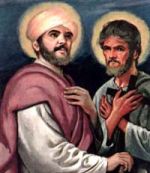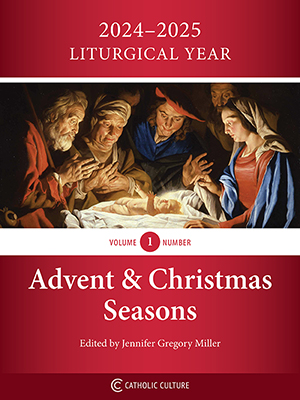Catholic Shrines Hard Hit by Tsunami in Asia
by Various
Velankanni, India — Four days after a giant tidal wave washed across Asian shores, and report of death tolls continued to climb by thousands an hour, the Catholic Church in Asia was particularly hard hit.
From India, George Iype reported for the Indian Internet new site rediff.com that hundreds of pilgrims at India's most famous Catholic shrine, the Basilica of Our Lady of Good Health in Velankanni, met a "watery death."
"We are still pulling out bodies from the beach. It would have been a celebration at this time of the year in our church. But sadly, our shrine has suddenly turned out to be a burial ground," the rector of the Shrine, Fr. Xavier told Iype.
The shrine attracts upwards of 20 million pilgrims seeking miracle cures each year, with December 26 drawing the largest crowds.
When the tsunami struck the coastal town basilica, thousands of sick and infirm Indians were nearby.
"It was meant to be a day of celebration," wrote Iype. "The Tamil Mass in the shrine was over the Malayalam Mass had begun. Hundreds of Malayalis from neighboring Kerala were attending Mass when tragedy struck.
"Those on the shore scurried for cover from the wall of water, but the force of the waves blew most of them away. Though the waves receded in the same lightening speed that it had come, hundreds were caught in the swirling waters and pulled back into the sea.
"But the killer tsunami crashed into the beach, the shrine's compound and nearby villages and hundreds of shops, homes, and pilgrims were washed away into the sea.
"The otherwise busy shrine on the seashore now wears a deserted look.
"The compound wall of the church collapsed under the force of the waves. The seawater did not enter the shrine because it is on a higher plane compared to the beach.
"But the waves took away hundreds of pilgrims who were on the beach. The water gushed into the main road and arterial lanes leading to the shrine, inundating several shops and houses.
" 'We have no idea how many people died. But I have been leading rescue teams all day and night. We have extricated more than 300 bodies,' said Fr. Xavier."
The history of the Our Lady of Good Health shrine, known as the "Lourdes of the East," dates back to the 16th century, when Our Lady appeared to a young shepherd boy, carrying milk from Velankanni to his master at Nagapattinam. Despite the early hour of the day, he became tired, and rested under a banyan tree and fell asleep. He awoke, startled, to see a Lady of exquisite beauty holding an infant, asking him for some milk.
According to a narrative provided on the Shrine's web site (www.annavailankanni.org), "The impatient master did not believe the narration of the boy. But to the greater astonishment of all present, the milk began to surge over the pot and flow out. On reaching the place of apparition, the gentleman and others began to believe in the heavenly Lady. This place began to be called, 'Our Lady's Tank.' "
Later in the 16th century, a local resident, a widow with a son, lame since birth, was visited by the Virgin, who appeared holding her son, and asked for a cup of buttermilk. "Then she directed him to go and inform a Catholic gentleman at Nagapattinam to put up a chapel in her name on the spot of her apparition. The boy realized that his lame legs had become normal upon the word from the Lady. With great joy, he buoyantly ran to Nagapattinam to carry out the errand. Having been already directed in a vision by Our Lady, the Catholic gentleman, with the support of the people, built a Chapel at 'Nadu Thittu' where now stands the present Shrine Basilica. The Lady was called, 'Our Lady of Good Health.'
Over the years, local Catholics continued to enlarge their shrine, and in November 1962, Pope John XXIII raised it to the level of a basilica.
The hardest hit of the Indian coastal towns, reported Nirmala Carvalho of AsiaNews, was nearby Nagapattinam, a small fishing village, where, by December 28, the death toll had passed the 7,000 mark.
"Nagapattinam morgues are overflowing with the bodies of dead children, many lying unclaimed, most probably because their parents, too, have perished under the waves of destruction," wrote Carvalho.
"The entire village is but a scene of devastation and annihilation," he added.
Bishop Devadass Ambrose, the local bishop, said he was devastated by the number of dead in Thanjavur, many of whom were Christians.
"I am heartbroken," he said. "So many have perished in an instant. The death toll is very high as many pilgrims came to the shrine for Christmas Mass. More than 500 bodies have been recovered so far, and many more pilgrims are still missing."
"This year," Bishop Ambrose said, "Christmas was on a Saturday. So, many devotees took advantage of the long weekend to make a pilgrimage to Our Lady of Velankanni. Unfortunately, for many of them, this was their final journey.
"Our town has turned into a mass graveyard. Many pilgrims are still missing and relief workers are now looking for bodies under debris."
The bishop added: "Near the shrine, the local fishing community has been nearly wiped out. Their fishing boats and nets are mere planks of wood and twine now.
"The Church authorities are working very closely with the army and the local administration in the relief operations. People have been camping in our parish schools and convents since the disaster. The priests of the parish have opened temporary medical camps providing medical aid to the people."
A distraught pilgrim from Bangalore who survived the ordeal said: "Every year I have been coming to Velankanni shrine for Christmas. [My family and I] were just strolling on the beach in the morning when the waves engulfed us."
Weeping, he added: "My wife and two sons have died, but I cannot return home to bury them since my three-year-old daughter is still missing. I have looked for her in the morgue but cannot find her."
Nearly 800 miles of India's coastline was devastated by the tidal waves, some as high as 60 feet tall and 90 miles long when they hit land.
"I am absolutely devastated to see the near annihilation of my diocese as well as 1,500 kilometers of India's coastline, said Archbishop Michael Augustine of Pondicherry-Cuddalore, one of the districts hardest hit by the tsunami in Tamil Nadu (South East India).
"This tragedy smashed and destroyed entire families, on the day we were to celebrate the Feast of the Holy Family," the archbishop told AsiaNews. "A Protestant church in Chinglepeth, about 100 kilometers away from our Cathedral, just caved in, killing instantly all the 100-odd worshipers who had gone there for Sunday service."
"A pall of gloom has descended upon Cuddalore," he went on to say, "People are in total shock and unable to react. Some 50 villages have been totally washed away."
But Archbishop Augustine is not giving in to disheartenment.
From early on the morning of December 27, the entire diocese mobilized in reaction to the emergency. "Our Fathers have gone into the remotest areas with medical and emergency relief materials. We hope to find some sign of life, as many people are missing and unaccounted for. All parishes and convent schools have been opened to provide shelter, clothes, food and drinking water. We have also set up temporary shelters in some villages."
"The nuns of Pondicherry and Cuddalore, a small town near Chennai (formerly Madras, the capital of Tamil Nadu) are taking women and children into their convents. It was a moving sight for me to see these distraught women and adolescents being brought to the convent for shelter, food and clothes," he said.
In Thailand
While much of the world's press focused on the sufferings of western tourists in Thailand, most notably in the homosexual resort at Phuket, considered one of the most scenic areas on earth, local priest Fr. Piergiacomo Urbani, a PIME missionary, told AsiaNews: "There are thousands of lost fishermen from the coast: no one is saying anything about these poor souls."
"Everyone here is taking interest in the tourist areas, like Phuket Island, and foreign victims, but the tidal waves hit practically Thailand's entire south-western coastline.
According to a Health Ministry statement released December 27, at least 50 foreigners have died, but their nationality is still not known. Local media reports say that among those missing are people from South Korea, Japan, South Africa, Hong Kong, Great Britain, Italy, Ireland, Denmark, Finland, Australia, Malaysia, Mexico, Russia, Sweden, Chile, the Czech Republic, Spain, the United States and Germany.
"People in Bangkok are grieved by the loss of so much human life," Fr. Urbani said. "Authorities say 800 people have died, 300 on Phuket alone, but the death toll will increase over coming days. No one knows what has become of the fishermen living along the hundreds of kilometers of coastline. This disaster is certainly a blow to the country, in terms of the loss of life and the effects on tourism: Christmas is high season as far as tourism is concerned. But, most of all, people here are dismayed by the loss of life. Yesterday, I was making my rounds to wish my parishioners a happy Christmas," said Fr. Urbani, who leads a parish in Nonthamburi.
Fr. Urbani told AsiaNews that the Thai Church is about to launch a campaign across parishes and Catholic schools to raise funds for the coast's fishermen.
Ecumenical Work in Sri Lanka
In predominantly Moslem Sri Lanka, the hardest hit by the tsunami, Catholic priests and Buddhist monks worked together to bring aid to the suffering and to organize relief services.
The Basilica of Our Lady of Lanka at Tewatta (north of Colombo) opened its doors to the displaced.
"I am surprised about the generosity of people," said Fr. Merl Shantha, the Basilica's administrator, which is part of the Archdiocese of Colombo. "Hundreds of men and women of every religious background are coming to help in the relief operations."
"Right now there are no religious, ethnic or racial differences," a Buddhist monk said. "We must be one to bring help to those in need."
"The tragedy," Fr. Shantha said, "has brought people together. Everyone is collecting food, clean water and clothes. We are all praying the Rosary, for ourselves and for the country."
The Archbishop of Colombo, Oswald Gomis, toured the devastated island, with his secretary, Fr. Sunil de Silva, who reported to AsiaNews stories of destruction involving churches, temples and houses.
"In Matara, south-east of Colombo, the waves swept away about 400 faithful as they were attending Sunday mass," Father de Silva said.
"In Payagala," he added, "the tsunami destroyed five churches, including a mission house."
The Jesuit Houses were spared though and are now being used as relief centers for victims.
The four communities in Galle, Trinciomale, Batticaloa, and Colombo opened their churches and residences to help the needy. The Jesuit Centre in Batticaloa is now sheltering up to 3,000 people.
© Wanderer Printing Co.
How to Help?
Catholic Relief Service (CRS), 1-800-736-3467
The Catholic Near East Welfare Association (CNEWA), 1-800-442-6392 or send checks payable to CNEWA to 1011 First Avenue, New York, NY 10022-4195.
This item 6275 digitally provided courtesy of CatholicCulture.org






